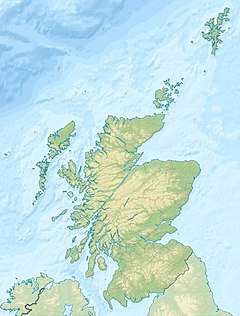| Falls of Foyers | |
|---|---|
 Falls of Foyers | |
 | |
| Location | Loch Ness, Highland, Scotland |
| Coordinates | 57°14′55″N 4°29′34″W / 57.24862°N 4.49269°W |
| Total height | 144 feet (44 m) |
The Falls of Foyers (Scottish Gaelic: Eas na Smùide, meaning the smoking falls) are two waterfalls on the River Foyers, which feeds Loch Ness, in Highland, Scotland. They are located on the lower portion of the River Foyers, and consist of the upper falls, with a drop of 46 feet (14 m) and the lower falls, which drop 98 feet (30 m).[1]
The falls were a popular destination for tourists using the pleasure steamers operating on Loch Ness, but in 1895, the North British Aluminium Company began building an aluminium smelting plant, which required large amounts of electricity. The hydro-electric station at the plant took large volumes of water from the River Foyers from an intake just above the falls, significantly reducing their flow. The plant was built without the need for Parliamentary approval, because the company bought the Lower Foyers estate, through which the river ran, and they were thus able to ignore the public outcry at the spoiling of an amenity. The works operated until 1967, with the original turbines which generated 3.75 MW remaining in use until the works closed.
The 1895 scheme had dammed Loch Garth and raised its level by 20 feet (6.1 m). Because it then joined Loch Farraline, the reservoir was renamed Loch Mhòr. This became the upper reservoir for a pumped-storage hydro-electric scheme when the newly closed works was taken over by the North of Scotland Hydro Electric Board. They installed a 5 MW turbine at the aluminium works, and constructed a tunnel from Loch Mhòr to feed a new power station located further to the north on the shore of Loch Ness. This has a capacity of 300 MW, and to preserve the amenity of the area, underground cables carry the power to a switching station some 3,000 feet (910 m) from the power station site. Further reductions to the flow over the falls have occurred as a result of diverting the River E into Loch Mhòr, and channelling most of the flow of the River Fechlin to it as well. Both formerly fed into the River Foyers, and hence the falls.
- ^ "Falls of Foyers, Great Glen: The Smoking Falls". Scottish Geology Trust. Archived from the original on 18 May 2022.
